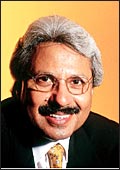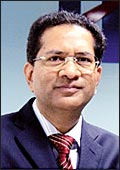 |
| Bigger the better: Ranbaxy's
Ohm subsidiary in the US |
Back in 2001, when Indian Hotels
Corporation Limited (IHCL) was implementing Total Productivity
Maintenance (TPM) and the Kaizen approach across its properties,
it benchmarked with the Ritz Carlton on customer satisfaction
measurements in luxury hotels. Just five years later, IHCL has
signed an agreement to acquire the Boston-based Ritz-Carlton hotel,
a luxury property in operation since May 19, 1927, for about $170
million. With the deal scheduled to close mid-January, this will
be the second us hotel to be acquired by the Tata Group company
(which owns the Taj chain of resorts and hotels), after it took
management control of The Pierre, a luxurious landmark hotel on
New York's 5th Avenue, for $50 million. Clearly, Indian Hotels
is morphing from being a leading Asian chain of luxury hotels
into a global one with presence in the gateway cities of the world.
In five years, it aims to have a third of its revenues from overseas
operations-and the US would account for a fair share of those
sales.
Indian Hotels is not the only company for which the US is a
key fragment of a globalisation blueprint. According to a CRISIL
report titled "Creating the Indian MNC", acquisitions
by Indian companies overseas have touched $7.3 billion in the
April 2005-September 2006 period. A little over a quarter of these
target companies are in the US, with the total deal value amounting
to a cool $1.9 billion. Tata Tea's $677-million acquisition of
a 30 per cent stake in the Glaceau, an enhanced water company,
is till date the largest us acquisition by an Indian company and
skews the us share substantially in 2006-07 to 52.7 per cent,
but the us was the #1 destination even in 2005-06 with an 18.3
per cent share of all overseas acquisitions.
 |
"Indian companies
should enter any market, and more specifically the US, from
a position of strength, that is in sectors like IT, textiles
& specialty teas"
Sunil Alagh
Chairman/ SKA Advisors |
 |
"Automated testing
is a high growth and large business opportunity. FocusFrame
will strengthen Hexaware's testing capabilities"
Atul Nishar
Chairman/ Hexaware |
Whilst niche American buyouts have been taking place for some
time now-it services majors like TCS, Wipro and Satyam have been
particularly busy as has a clutch of pharma majors-a handful of
Indian corporations are now beginning to make us acquisitions
for sheer size and scale. Rain Calcining Ltd, Asia's largest manufacturer
of calcined petroleum coke (CPC), acquired a 20 per cent stake
in GLC Carbon Corporation and is reportedly looking to acquire
full control. If successful, Rain will emerge the world's largest
producer of CPC. Rain has the capacity to manufacture 480,000
tonnes per annum of CPC, while GLC, with its four facilities in
Texas, Oklahoma, Louisiana and Argentina, is about four times
the size with an annual capacity of 2.3 million tonnes. Clearly,
scale is an important factor in influencing the decision for Rain
Calcining as market leadership brings with it the ability to influence
pricing, especially in a commodity industry.
For other manufacturers with global ambitions, the US is one
land that they just can't ignore. When last June, Bharat Forge,
the second largest forgings firm in the world, purchased Federal
Forge Inc., a company engaged in the design and manufacture of
complex forged steel components, for $9.1 million, it gained an
immediate foothold in the us passenger car and light truck market;
and most importantly, a manufacturing base close to some of Bharat
Forge's largest customers.
Access to markets has been a key driver of these acquisitions
and the US being the largest market in the world, has been a big
draw. Says Sunil Alagh, Chairman, SKA Advisors, a Mumbai-based
marketing and branding consultancy: "The level of importance
of entering the us markets depends on the product. Indian companies
should enter any market and more specifically the US, from a position
of strength, that is in sectors like it, textiles, specialty teas,
Indian cuisine-based foods, etc. It will be of little importance
in areas like soaps, cosmetics, confectionery or air conditioners.
Entering the us market should not be a 'fashion' but 'opportunity-based'."
The Indian textiles industry has been trying something similar-to
make inroads into the $30-billion (Rs 1,35,000-crore) US and EU
home textiles market by aligning its low-cost manufacturing base
with us-based brands. Companies like GHCL have chosen to grow
via the inorganic route-it acquired Dan River, the third largest
player in the us home textiles market, the owner of the brand
'Bed in a Bag' and preferred supplier to large retailers like
JC Penny and Linen & Things, Wal-Mart and Bed, and Bath &
Beyond. GHCL Joint Managing Director R.S. Jalan says: "The
acquisition provides us the opportunity to quickly move into the
us market with a ready customer base and infrastructure in place."
S. Kumars, too, is reportedly bidding for one of the largest American
home furnishing manufacturing and distribution companies, America
Pacific, and the deal size is rumoured to be in the range of $100-120
million (Rs 450-540 crore). America Pacific supplies bedding,
bath and window products to many us brands, including Nautica,
Dockers and Liz Claiborne. It also makes and markets home linen
under its own brand.
So, how much of an imperative is penetrating the us-the final
frontier in some ways-for Indian companies with MNC ambitions?
Rama Bijapurkar, an independent market strategy expert, explains
that America shouldn't be blindly pursued because it's potentially
the most lucrative market. Rather, the importance of a country
must be based on how feasible it is to build a decent sized, profitable,
and competitive position. "So, if that is better done in
Africa or Uzbekistan or UK, why not?" asks Bijapurkar. That
may explain why some Indian companies have made big-ticket acquisitions
in less likely regions-Suzlon in Belgium, Aban Loyd Chiles in
Norway and Gail in Bermuda.
|







